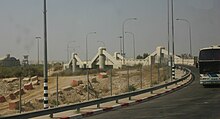Allenby Bridge
Allenby Bridge גשר אלנבי جسر الملك حسين | |
|---|---|
 Allenby Bridge from the Jordanian side | |
| Coordinates | 31°52′27″N 35°32′27″E / 31.8742°N 35.5408°E |
| Carries | Pedestrians, vehicles |
| Crosses | Jordan River |
| Locale | Jordan West Bank |
| Official name | Allenby/King Hussein Bridge מסוף אלנבי جسر الملك حسين |
| Maintained by | Hashemite Kingdom of Jordan Israel Airports Authority |
| History | |
| Construction start | 1918 |
| Opened | 1994 |
| Rebuilt | 1968, 1994 |
| Statistics | |
| Daily traffic | 1.2 million pedestrians in 2007 and 12,000 trucks[1] |
| Toll | ₪176.00 (Outbound West Bank) ₪155.00 (Outbound West Bank - Palestinians only) JD10.00 (Outbound Jordan) |
| Location | |
 | |
Coordinates: 31°52′27″N 35°32′27″E / 31.87417°N 35.54083°E The Allenby Bridge (English name; Hebrew: גשר אלנבי Gesher Allenby), known officially in Jordan as the King Hussein Bridge (Arabic: جسر الملك حسين Jisr al-Malek Hussein), and also called Al-Karameh Bridge by Palestinian Arabs, is a bridge that crosses the Jordan River near the city of Jericho, and connects the West Bank with Jordan. The bridge is currently the sole designated exit/entry point for West Bank Palestinians traveling abroad.
Being 381 meters (1,250 ft) below sea level, it is the lowest fixed water crossing in the world
History[]
In 1885 the Ottoman government of the Mutasarrifate of Jerusalem built a bridge at this site.[2]
In 1918 British general Edmund Allenby built a bridge over the remnant of the Ottoman predecessor.[2] It was first destroyed by the 1927 Jericho earthquake, when it fell apart and collapsed into the river.[3]
It was destroyed again in the Night of the bridges operation by Palmach on 16 June 1946, thus severing one of the main overland connections between Mandatory Palestine and Transjordan.[citation needed] The next destruction occurred during the 1967 Six-Day War, after which was replaced in 1968 with a temporary truss-type bridge.[citation needed] In 1994, subsequent to the Israel-Jordan peace treaty, a new modern paved crossing was constructed adjacent to the older wooden one with the aid of the Japanese Government.[4]
The Allenby border crossing[]
Since the 1994 Israel–Jordan peace treaty, the Allenby Bridge Terminal is operated by the Israel Airports Authority.[5] It serves as a border crossing between the West and East Banks of the Jordan River. The Jordanian authorities recognize the bridge as an international border entry point, but neither grant entry visas to foreign passport holders at this crossing, unlike the country's other border crossings with Israel,[6] nor stamp the passports of departing travelers.[7] Palestinians traveling abroad can use Allenby Bridge to exit the West Bank into Jordan and then use the Queen Alia International Airport in Amman to fly abroad. Travel permits from both Israeli and Jordanian authorities are required, with varied stringency depending on the prevailing political situation.
Israeli citizens are not permitted to use the terminal, except pilgrims to Mecca, the Hajj and Omra.[5] Tourists who wish to travel to Jordan may have to be in possession of a visa from Jordan in advance, depending on their nationality. Tourists and inhabitants of East Jerusalem may travel directly to an Israeli terminal, although Palestinians from the West Bank have to start the departure procedure at the special Palestinian border terminal in Jericho city.
The Jordanian side of the bridge has a branch of the Bank of Jordan for the exchange of currencies.[8]

The opening of the original Allenby Bridge in 1918

Larger bridge built in the 1930s next to the original one visible behind it

Allenby (King Hussein) Bridge after being blown up by the Palmach in 1946

The bridge after being destroyed by Israel during the 1967 Six Day War

King Hussein Bridge title, 2013
In the Arts[]
The Allenby crossing is the locus of a 1971 song by Nurit Hirsh, Gesher Bailey (Bailey bridge - referring to the temporary truss bridge).
See also[]
- Death of Raed Zeiter
References[]
- ^ http://www.iaa.gov.il/Rashat/he-IL/Rashot/BrowserSystemMessage.aspx[bare URL]
- ^ Jump up to: a b Hamidian Palestine: Politics and Society in the District of Jerusalem 1872-1908 p448
- ^ Palestine Square (11 July 2016). "And the Land Lurched Forth: Remembering the 1927 Jericho Earthquake". Institute for Palestine Studies (IPS). Retrieved 8 April 2020.
- ^ "Embassy of Japan in Jordan (ODA: Middle East Peace & Regional Stability)".
- ^ Jump up to: a b The History of the Terminal. Israel Airports Authority
- ^ Irving, Sarah (2012). Palestine. Bradt Travel Guides. p. 30. ISBN 9781841623672. Retrieved September 14, 2015.
- ^ Walker, Jenny; Clammer, Paul (2015). Lonely Planet Jordan. Lonely Planet. p. 730. ISBN 9781743605462. Retrieved September 15, 2015.
- ^ "Bank of Jordan פתח סניף בגשר אלנבי" (in Hebrew). Port2Port. 2008-07-24. Archived from the original on 2008-08-02. Retrieved 2008-07-25.
External links[]
| Wikimedia Commons has media related to Allenby Bridge. |
- Bridges completed in 1968
- Bridges in Jordan
- Bridges over the Jordan River
- Jordan–West Bank border crossings
- Toll bridges





